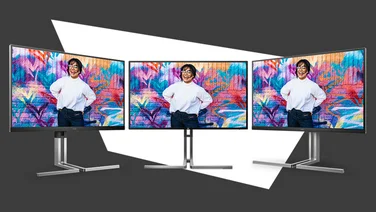To help us provide you with free impartial advice, we may earn a commission if you buy through links on our site. Learn more




Asus’s VG236H is a 3D monitor, which is compatible with, and comes bundled alongside Nvidia’s well-established 3D Vision technology. The 3D Vision component consists of a pair of shutter-based glasses, plus a USB control unit that synchronises the screen’s image with them. You’ll need an Nvidia graphics card to use 3D Vision, thankfully the company has raised its game recently, with good mid-range cards such as the GTX 460.

The monitor is capable of running at 120Hz, with the shutter glasses directing alternate frames to each eye, so that the 3D image appears to run at 60Hz. Although this should be adequate for a stable image, you’re still aware of flickering while using the glasses. There’s an eye test when you first install the software for the glasses, and if you don’t pass it you’re advised not to use the system at all. If you’re not certain about your ability to see 3D images, then buy from a retailer with a good returns policy.

In terms of 2D image quality, the VG236H was impressive, with bold colours and reasonably good contrast. The menu system is clear and easy to use, although many of the options for Asus’s Splendid technology produced an overblown, over-saturated image. Colour accuracy seemed good, although it erred on the side of warmth.
Nvidia’s site has demonstrations of 3D photos and videos, but it’s worth mentioning that 3D capture is still in its infancy. Although you can buy 3D cameras and camcorders, such as the Panasonic HDC-SDT750 they are still very expensive. 3D Vision has support for 3D Blu-ray, so if you have a Blu-ray drive you could enjoy feature films in 3D too.
Where the VG236H excels is at playing games, with a long list of supported titles, although it still has issues. First-person and action games, such as Just Cause 2, are where 3D really comes alive. Moving around in a virtual world allows the 3D technology to add a real sense of depth and spatial awareness. The added dimension allowed us to more easily find our way around and be more aware of our surroundings.

The problem with 3D is that, because it makes the world more real, your eyes demand more detail and realism in the textures and construction of the world. Poorly-crafted models stick out as anomalies, and bump-mapped textures that mimic 3D for a 2D viewer become superfluous and spoil the 3D image. Violent changes in perspective that can be quite unsettling, and over long periods we wouldn’t be surprised if most people felt a touch of travel sickness.
Some effects work better than others. Water looks gorgeous, in both games and in videos, but in photos it looks oddly solid, like jelly. Explosions look suitably dangerous, while highly reflective surfaces, such as chrome, can either add to the depth of an image, or create jarring anomalies if they reflect a bright light source.

Text is another problem: we tested the VG236H with Civilization V, and although the 3D units and landscape were convincing, text was almost unreadable, no matter how much we adjusted the 3D depth. Moreover, the information panels were displayed at a near distance, so our eyes had to re-focus quite a bit between these and the game world itself.
As a novelty for avid gamers, the VG236H is impressive, but even then many will balk at the £370 price tag. You can get a decent 2D monitor for less than half this price, and the VG236H ties you to Nvidia graphics cards. Upcoming 3D monitors, from Asus and others, will instead use the 3D standards that are part of HDMI 1.4a. These are supported by all the latest graphics cards from ATI and Nvidia, as well as consumer devices such as Blu-ray players. This makes the VG236H a costly dead end, and so we can’t recommend it.






